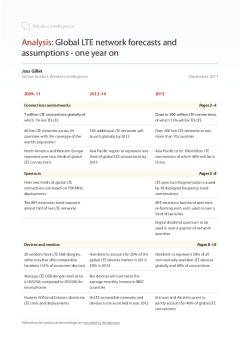Global LTE network forecasts and assumptions - one year on - Over 200 live LTE networks forecast by 2015 using 38 spectrum frequency combinations

Please complete the form below or register for a free public account to access this report.
Report details
Global LTE network forecasts and assumptions - one year on - Over 200 live LTE networks forecast by 2015 using 38 spectrum frequency combinations
Our latest report — Global LTE network forecasts and assumptions - one year on — is now available for download.
GSMA Intelligence predicts that there will be 38 different spectrum frequency combinations used in LTE deployments by 2015, a fragmented scenario fuelled by ongoing spectrum auctions, licence renewals and re-farming initiatives across a wide range of frequency bands.
The lack of spectrum harmonisation represents a key challenge for the emerging LTE ecosystem, potentially preventing vendors from delivering globally compatible LTE products such as devices and chipsets.
Spectrum fragmentation has the potential to hinder global LTE roaming if device manufacturers are required to include support for many disparate frequencies in their devices. Given the backwards compatibility already required for either HSPA or EV-DO connectivity, we are unlikely to see a 'world' device in a handset form-factor soon.
GSMA Intelligence forecasts that there will be over 200 live LTE networks in more than 70 countries by 2015, up from 40 networks in 24 countries today. The number of LTE connections is forecast to grow from 7 million to close to 300 million over the same period.
Download the Report
Complete the form below to get instant access to this report. For easier access in the future, you can register for a free account here.
Report details
Global LTE network forecasts and assumptions - one year on - Over 200 live LTE networks forecast by 2015 using 38 spectrum frequency combinations
Related research
5G and network transformation: five trends to watch in 2026
How will the industry evolve in 2026? This series of reports highlights the key trends to watch and the implications for ecosystem players. This report examines 5G and network transformation.
GSMA Open Gateway: State of the Market, H2 2025
In the latest edition of the GSMA Open Gateway research series, key developments for H2 2025 include the segmentation of industry demand, and the continued deployment of APIs in categories other than fraud and security. The report provides an update on the state of the market, recent developments and examples of GSMA Open Gateway in action.
Network Transformation 2026
In GSMA Intelligence’s seventh annual survey of network technology executives, one data point stands out: 85% of operators claim opex efficiencies as a priority business objective for deploying AI in their networks.
Authors
How to access this report
Annual subscription: Subscribe to our research modules for comprehensive access to more than 200 reports per year.
Enquire about subscriptionContact our research team
Get in touch with us to find out more about our research topics and analysis.
Contact our research teamMedia
To cite our research, please see our citation policy in our Terms of Use, or contact our Media team for more information.
Learn moreRelated research
5G and network transformation: five trends to watch in 2026
How will the industry evolve in 2026? This series of reports highlights the key trends to watch and the implications for ecosystem players. This report examines 5G and network transformation.
GSMA Open Gateway: State of the Market, H2 2025
In the latest edition of the GSMA Open Gateway research series, key developments for H2 2025 include the segmentation of industry demand, and the continued deployment of APIs in categories other than fraud and security. The report provides an update on the state of the market, recent developments and examples of GSMA Open Gateway in action.
Network Transformation 2026
In GSMA Intelligence’s seventh annual survey of network technology executives, one data point stands out: 85% of operators claim opex efficiencies as a priority business objective for deploying AI in their networks.
- 200 reports a year
- 50 million data points
- Over 350 metrics
